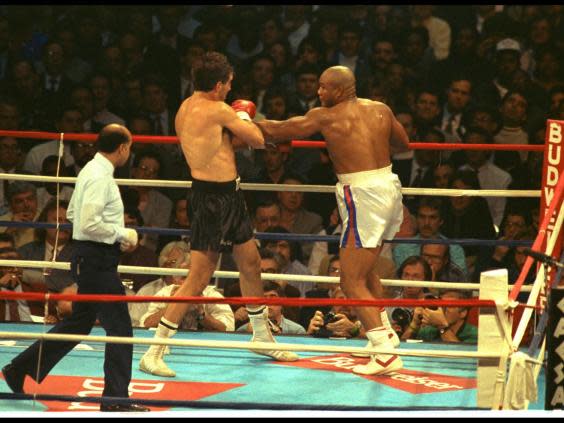To the brink and back: The story behind Gerry Cooney’s road to recovery
It was June 1982 in Las Vegas, 100 degrees in the shade, if you could find any, and police snipers were on the roof at Caesars for a heavyweight fight that stopped America.
In one corner was the unbeaten champion, Larry Holmes, still treading uneasily down Muhammad Ali’s path of glory. Opposite him was the Great White Hope, Gerry Cooney, also unbeaten and with the apparent backing of just about every star in town. Well, certainly the white stars in Las Vegas. The Klan had promised to shoot Holmes if he won and a gang of black nationalists had promised to the do the same to Cooney. The law positioned their sharpshooters to clean up the promised mess from the vigilante horde. It was quite a night in Las Vegas.
“I hated that Great White Hope name, I hated all the negative stuff,” said Cooney. “It was just the two best heavyweights, both unbeaten and in their primes. That was meant to be what it was about.” It finished in the 13th of 15 rounds, Cooney bloody, hurt, reeling and truly broken. The physical pain was the easy part; the bruises fade, the cuts heal and the swellings all over a battered body recede with time. However, away from the punches Cooney was soon out of control on a scale that often defies belief. He has been sober for over 30 years.
“Larry is now a great friend but after the fight I needed answers and I wanted a rematch,” said Cooney. “Why didn’t I get a rematch? It was a great fight – forget the hype. We put on a truly memorable heavyweight title fight.” It was tight at the end, Holmes was leading but Cooney had been docked three points for illegal tactics and without those deductions, the challenger would have been in front on two of the three scorecards. Cooney would have won a 12-round fight without the lazy infringements.
In the three fights before Cooney fought Holmes, the New Yorker had left an impressive trail of destruction in a heavyweight division slowly adjusting to life without Ali. Cooney had been a professional boxer since 1977, had started to be noticed as he smashed and bashed away at the usual suspects. He was 6ft 6in, of Irish descent, loved a publicity stunt and could fight. He had represented Young America one night as an amateur at the Hilton in London’s Park Lane and destroyed a man called Joey Griffin. Big, indestructible Joe had been a childhood hero of mine; I certainly knew about Cooney.
Gentlemen Gerry stopped Jimmy Young in four, Ron Lyle in one round and Ken Norton in just 54 seconds at a sold-out Madison Square Garden in 1981. The three had been heavyweight royalty, men in great fights from the Seventies, still considered the sport’s finest decade for heavyweight boxing. Cooney’s credentials after the trio of wins, even if all three men had aged since their best nights, were impeccable. Holmes, the champion who had beaten Norton over 15 rounds two years earlier, had to finally agree to a fight. The racial spin came from Don King and was blatant, but also commercially shrewd.
Cooney never recovered, never got his rematch and threatened to drive to Easton, Pennsylvania, where Holmes lived, to challenge the champion to a street fight. “I was searching for answers – I needed to know what went wrong?” said Cooney. In the days, weeks, months and years after that fight ended, Cooney would ramble an apology in bars, at fights and often alone with just his darkest of memories for desperate company with the drugs and drink that had taken over his life. Cooney was lost, but he was still under 30 and the Holmes defeat was his only one. In other words, the Great White Hope could come again.
Five years after the Holmes fight there was another big fight and payday for Cooney, this time against Michael Spinks, who had twice beaten Holmes. No official title was on the line that night in Atlantic City, but Spinks was the lineal champion, unbeaten in 30 fights. Cooney lost in the 5th of a scheduled 15-round fight. He was a wreck away from the ring, a drunk in a fight that was only worth taking for the cash. It was nearly the end for Gentleman Gerry.

The ring career of Gerry Cooney finished in his next fight, three years later in 1990 when another sold-out crowd at the Garden, a venue Cooney had owned since his amateur days, watched Big George Foreman stop him in just two rounds. Cooney’s road to recovery had started and this Friday at Bar Sport in Cannock he will tell his story. Make no mistake: you will hear a great heavyweight talk, a man with a foot across the decades who, for one sweltering night in 1982, was part of one of the very last heavyweight fights to stop America. On that night Gerry Cooney was the greatest contender. It was also his first step on the road to recovery.
Gentleman Gerry: A Contender in the Ring, a Champion in Recovery by Gerry Cooney is out now.
Gerry Cooney is Live this Friday at Bar Sport, Cannock.
